前言:
- 本篇博客整理了几道关于栈和队列的OJ题,着重介绍栈和队列之间的互相实现,以及循环队列
- 代码实现:C语言
- 题目来源:LeetCode
- 题目链接:
1. 有效的括号
- LeetCode链接:有效的括号
- 题目描述:
- 解决思路:利用栈的特性,先进后出,遍历字符串,把左边的符号(‘(’、‘[’、‘{’)依次存到栈中,然后再逐个出栈和字符串后面的右边的符号比对,符合题意的则继续往下操作。
- AC代码如下:
typedef char STDateType;//细节
typedef struct Stack
{
STDateType* a;
int top;
int capacity;
}ST;
void StackInit(ST* ps);
void StackDestroy(ST* ps);
void StackPush(ST* ps, STDateType x);
void StackPop(ST* ps);
STDateType StackTop(ST* ps);
bool StackEmpty(ST* ps);
int StackSize(ST* ps);
void StackInit(ST* ps)
{
assert(ps);
ps->a = NULL;
ps->top = 0;
ps->capacity = 0;
}
void StackDestroy(ST* ps)
{
assert(ps);
free(ps->a);
ps->a = NULL;
ps->top = 0;
ps->capacity = 0;
}
void StackPush(ST* ps, STDateType x)
{
assert(ps);
if (ps->top == ps->capacity)
{
int newCapacity = ps->capacity == 0 ? 4 : ps->capacity * 2;
STDateType* tmp = (STDateType*)realloc(ps->a, sizeof(STDateType) * newCapacity);
if (tmp == NULL)
{
printf("realloc fail\n");
exit(-1);
}
ps->a = tmp;
ps->capacity = newCapacity;
}
ps->a[ps->top] = x;
ps->top++;
}
void StackPop(ST* ps)
{
assert(ps);
assert(!StackEmpty(ps));
ps->top--;
}
STDateType StackTop(ST* ps)
{
assert(ps);
assert(!StackEmpty(ps));
return ps->a[ps->top - 1];
}
bool StackEmpty(ST* ps)
{
assert(ps);
return ps->top == 0;
}
int StackSize(ST* ps)
{
return ps->top;
}
//
bool isValid(char * s){
ST st;
StackInit(&st);
while(*s)
{
if(*s == '('
|| *s == '['
|| *s == '{')
{
StackPush(&st, *s);
++s;
}
else
{
if(StackEmpty(&st))
{
StackDestroy(&st);
return false;
}
STDateType top = StackTop(&st);
StackPop(&st);
if((top == '{' && *s == '}')
|| (top == '(' && *s == ')')
|| (top == '[' && *s == ']'))
{
++s;
}
else
{
StackDestroy(&st);
return false;
}
}
}
bool ret = StackEmpty(&st);
StackDestroy(&st);
return ret;
}
- 注意:在返回bool值之前,要将创建的栈销毁,防止内存泄漏。还有诸多控制细节,都在代码中。
2. 用队列实现栈
- LeetCode链接: 用队列实现栈
- 题目描述:
- 解决思路:用C语言解决的话,就得先把队列写出来,才能进行模拟,这里,我们直接调用之前写好的队列即可
- AC代码如下:
//链式结构:表示队列
typedef int QDateType;
typedef struct QueueNode
{
struct QueueNode* next;
QDateType date;
}QNode;
//队列的结构
typedef struct Queue
{
//int size;
QNode* head;
QNode* tail;
}Queue;
//初始化队列
void QueueInit(Queue* pq);
//销毁队列
void QueueDestroy(Queue* pq);
//队尾入队列
void QueuePush(Queue* pq, QDateType x);
//队头出队列
void QueuePop(Queue* pq);
//获取队列头部元素
QDateType QueueFront(Queue* pq);
//获取队列队尾元素
QDateType QueueBack(Queue* pq);
//检测队列是否为空
bool QueueEmpty(Queue* pq);
//获取队列的长度(队列中存放数据的个数)
int QueueSize(Queue* pq);
void QueueInit(Queue* pq)
{
assert(pq);
pq->head = NULL;
pq->tail = NULL;
}
void QueueDestroy(Queue* pq)
{
assert(pq);
QNode* cur = pq->head;
while (cur)
{
QNode* next = cur->next;
free(cur);
cur = next;
}
pq->head = pq->tail = NULL;
}
void QueuePush(Queue* pq, QDateType x)
{
assert(pq);
QNode* newnode = (QNode*)malloc(sizeof(QNode));
if (newnode == NULL)
{
printf("malloc fail");
exit(-1);
}
newnode->date = x;
newnode->next = NULL;
if (pq->tail == NULL)
{
pq->head = pq->tail = newnode;
}
else
{
pq->tail->next = newnode;
pq->tail = newnode;
}
}
void QueuePop(Queue* pq)
{
assert(pq);
assert(!QueueEmpty(pq));
if (pq->head->next == NULL)//只剩下一个结点
{
free(pq->head);
pq->head = pq->tail = NULL;
}
else//多个结点
{
QNode* next = pq->head->next;
free(pq->head);
pq->head = next;
}
}
QDateType QueueFront(Queue* pq)
{
assert(pq);
assert(!QueueEmpty(pq));
return pq->head->date;
}
QDateType QueueBack(Queue* pq)
{
assert(pq);
assert(!QueueEmpty(pq));
return pq->tail->date;
}
bool QueueEmpty(Queue* pq)
{
assert(pq);
return pq->head == NULL;
}
int QueueSize(Queue* pq)
{
assert(pq);
int size = 0;
QNode* cur = pq->head;
while (cur)
{
size++;
cur = cur->next;
}
return size;
}
//*******
typedef struct {
Queue q1;
Queue q2;
} MyStack;
MyStack* myStackCreate() {
MyStack* obj = (MyStack*)malloc(sizeof(MyStack));
QueueInit(&obj->q1);
QueueInit(&obj->q2);
return obj;
}
void myStackPush(MyStack* obj, int x) {
if(!QueueEmpty(&obj->q1))
{
QueuePush(&obj->q1,x);
}
else
{
QueuePush(&obj->q2,x);
}
}
int myStackPop(MyStack* obj) {
Queue* emptyQ = &obj->q1;
Queue* nonEmptyQ = &obj->q2;
if(!QueueEmpty(&obj->q1))
{
emptyQ = &obj->q2;
nonEmptyQ = &obj->q1;
}
while(QueueSize(nonEmptyQ) > 1)
{
QueuePush(emptyQ,QueueFront(nonEmptyQ));
QueuePop(nonEmptyQ);
}
int top = QueueFront(nonEmptyQ);
QueuePop(nonEmptyQ);
return top;
}
int myStackTop(MyStack* obj) {
if(!QueueEmpty(&obj->q1))
{
return QueueBack(&obj->q1);
}
else
{
return QueueBack(&obj->q2);
}
}
bool myStackEmpty(MyStack* obj) {
return QueueEmpty(&obj->q1) && QueueEmpty(&obj->q2);
}
void myStackFree(MyStack* obj) {
QueueDestroy(&obj->q1);
QueueDestroy(&obj->q2);
free(obj);
}
/**
* Your MyStack struct will be instantiated and called as such:
* MyStack* obj = myStackCreate();
* myStackPush(obj, x);
* int param_2 = myStackPop(obj);
* int param_3 = myStackTop(obj);
* bool param_4 = myStackEmpty(obj);
* myStackFree(obj);
*/
- 注意:本题利用队列模拟了栈,深度复习了栈和队列的相关知识
3. 用栈实现队列
- LeetCode链接:用栈实现队列
- 题目描述:
- 解决思路:有了第二题的基础,这题也是利用两个栈来回倒数据,可实现队列先进先出的特性,有点类似,但又有一些细节。C语言解决,这里也是要先把栈给写出来,才能进行模拟队列,这里我们也是直接调用之前写好的栈。
- AC代码如下:
//动态的栈 支持动态增长
typedef int STDateType;
typedef struct Stack
{
STDateType* a;
int top;//栈顶
int capacity;//容量
}ST;
//初始化栈
void StackInit(ST* ps);
//销毁栈
void StackDestroy(ST* ps);
//入栈
void StackPush(ST* ps, STDateType x);
//出栈
void StackPop(ST* ps);
//获取栈顶元素
STDateType StackTop(ST* ps);
//检测栈是否为空
bool StackEmpty(ST* ps);
//获取栈的长度(栈中存放数据的个数)
int StackSize(ST* ps);
void StackInit(ST* ps)
{
assert(ps);
ps->a = NULL;
ps->top = 0;
ps->capacity = 0;
}
void StackDestroy(ST* ps)
{
assert(ps);
free(ps->a);
ps->a = NULL;
ps->top = 0;
ps->capacity = 0;
}
void StackPush(ST* ps, STDateType x)
{
assert(ps);
if (ps->top == ps->capacity)
{
int newCapacity = ps->capacity == 0 ? 4 : ps->capacity * 2;
STDateType* tmp = (STDateType*)realloc(ps->a, sizeof(STDateType) * newCapacity);
if (tmp == NULL)
{
printf("realloc fail\n");
exit(-1);
}
ps->a = tmp;
ps->capacity = newCapacity;
}
ps->a[ps->top] = x;
ps->top++;
}
void StackPop(ST* ps)
{
assert(ps);
assert(!StackEmpty(ps));
ps->top--;
}
STDateType StackTop(ST* ps)
{
assert(ps);
assert(!StackEmpty(ps));
return ps->a[ps->top - 1];
}
bool StackEmpty(ST* ps)
{
assert(ps);
return ps->top == 0;
}
int StackSize(ST* ps)
{
return ps->top;
}
//***************
typedef struct {
ST pushst;
ST popst;
} MyQueue;
MyQueue* myQueueCreate() {
MyQueue* obj = (MyQueue*)malloc(sizeof(MyQueue));
StackInit(&obj->pushst);
StackInit(&obj->popst);
return obj;
}
void myQueuePush(MyQueue* obj, int x) {
StackPush(&obj->pushst,x);
}
int myQueuePop(MyQueue* obj) {
if(StackEmpty(&obj->popst))
{
// 如果pop栈为空,则把push栈的数据倒过来
while(!StackEmpty(&obj->pushst))
{
StackPush(&obj->popst,StackTop(&obj->pushst));
StackPop(&obj->pushst);
}
}
int front = StackTop(&obj->popst);
StackPop(&obj->popst);
return front;
}
int myQueuePeek(MyQueue* obj) {
if(StackEmpty(&obj->popst))
{
// 如果pop栈为空,则把push栈的数据倒过来
while(!StackEmpty(&obj->pushst))
{
StackPush(&obj->popst,StackTop(&obj->pushst));
StackPop(&obj->pushst);
}
}
return StackTop(&obj->popst);
}
bool myQueueEmpty(MyQueue* obj) {
return StackEmpty(&obj->popst) && StackEmpty(&obj->pushst);
}
void myQueueFree(MyQueue* obj) {
StackDestroy(&obj->pushst);
StackDestroy(&obj->popst);
free(obj);
}
/**
* Your MyQueue struct will be instantiated and called as such:
* MyQueue* obj = myQueueCreate();
* myQueuePush(obj, x);
* int param_2 = myQueuePop(obj);
* int param_3 = myQueuePeek(obj);
* bool param_4 = myQueueEmpty(obj);
* myQueueFree(obj);
*/
4. 设计循环队列(***)
- LeetCode链接:设计循环队列
- 题目描述:是比较恶心的一道题😅😅😅
- 解决思路:
下面先介绍循环队列
- AC代码如下:
typedef struct {
int* a;
int k;
int head;
int tail;
} MyCircularQueue;
//声明
bool myCircularQueueIsFull(MyCircularQueue* obj);
bool myCircularQueueIsEmpty(MyCircularQueue* obj);
MyCircularQueue* myCircularQueueCreate(int k) {
MyCircularQueue* obj = (MyCircularQueue*)malloc(sizeof(MyCircularQueue));
obj->a = (int*)malloc(sizeof(int)*(k+1));
obj->head = obj->tail = 0;
obj->k = k;
return obj;
}
bool myCircularQueueEnQueue(MyCircularQueue* obj, int value) {
if(myCircularQueueIsFull(obj))
return false;
obj->a[obj->tail] = value;
obj->tail++;
if(obj->tail == obj->k+1)
obj->tail = 0;
return true;
}
bool myCircularQueueDeQueue(MyCircularQueue* obj) {
if(myCircularQueueIsEmpty(obj))
return false;
obj->head++;
if(obj->head == obj->k+1)
obj->head = 0;
return true;
}
int myCircularQueueFront(MyCircularQueue* obj) {
if(myCircularQueueIsEmpty(obj))
return -1;
return obj->a[obj->head];
}
int myCircularQueueRear(MyCircularQueue* obj) {
if(myCircularQueueIsEmpty(obj))
return -1;
int prev = obj->tail-1;
if(obj->tail == 0)
prev = obj->k;
return obj->a[prev];
}
bool myCircularQueueIsEmpty(MyCircularQueue* obj) {
return obj->head == obj->tail;
}
bool myCircularQueueIsFull(MyCircularQueue* obj) {
int next = obj->tail + 1;
if(next == obj->k+1)
next = 0;
return next == obj->head;
}
void myCircularQueueFree(MyCircularQueue* obj) {
free(obj->a);
free(obj);
}
/**
* Your MyCircularQueue struct will be instantiated and called as such:
* MyCircularQueue* obj = myCircularQueueCreate(k);
* bool param_1 = myCircularQueueEnQueue(obj, value);
* bool param_2 = myCircularQueueDeQueue(obj);
* int param_3 = myCircularQueueFront(obj);
* int param_4 = myCircularQueueRear(obj);
* bool param_5 = myCircularQueueIsEmpty(obj);
* bool param_6 = myCircularQueueIsFull(obj);
* myCircularQueueFree(obj);
*/
学习记录:
- 本篇博客整理于2022.7.4
- 请多多指教🌹🌹🌹








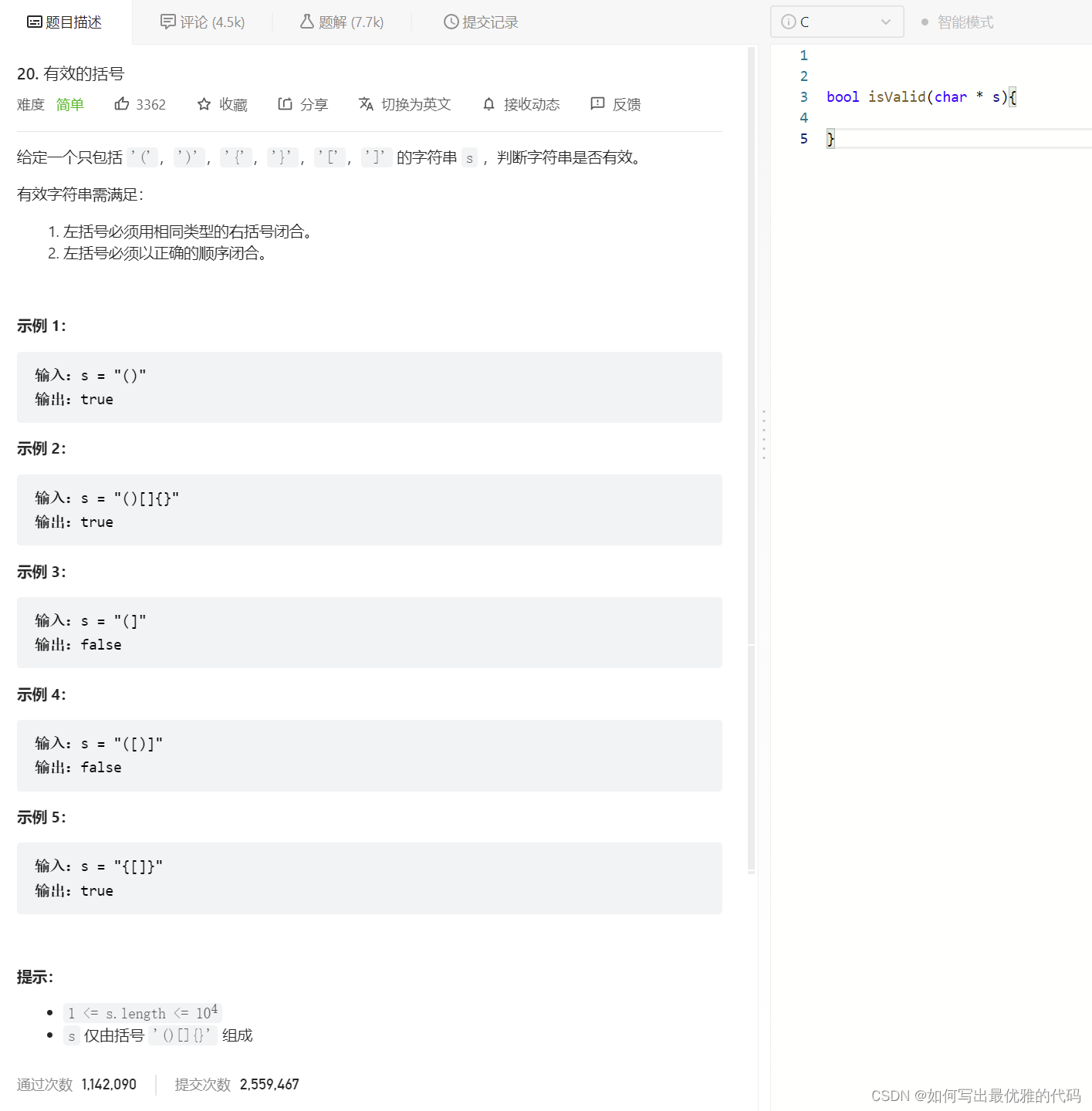
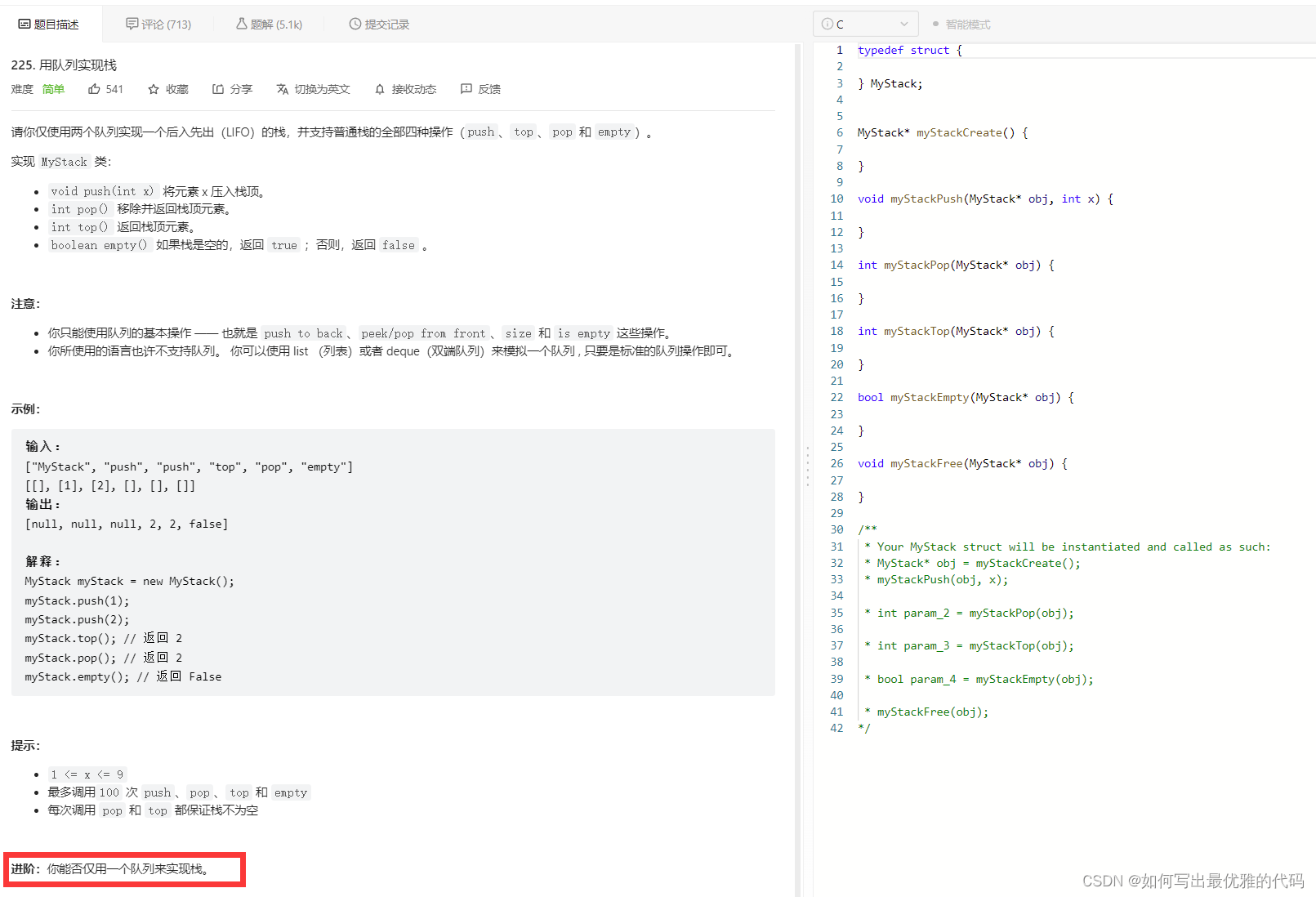
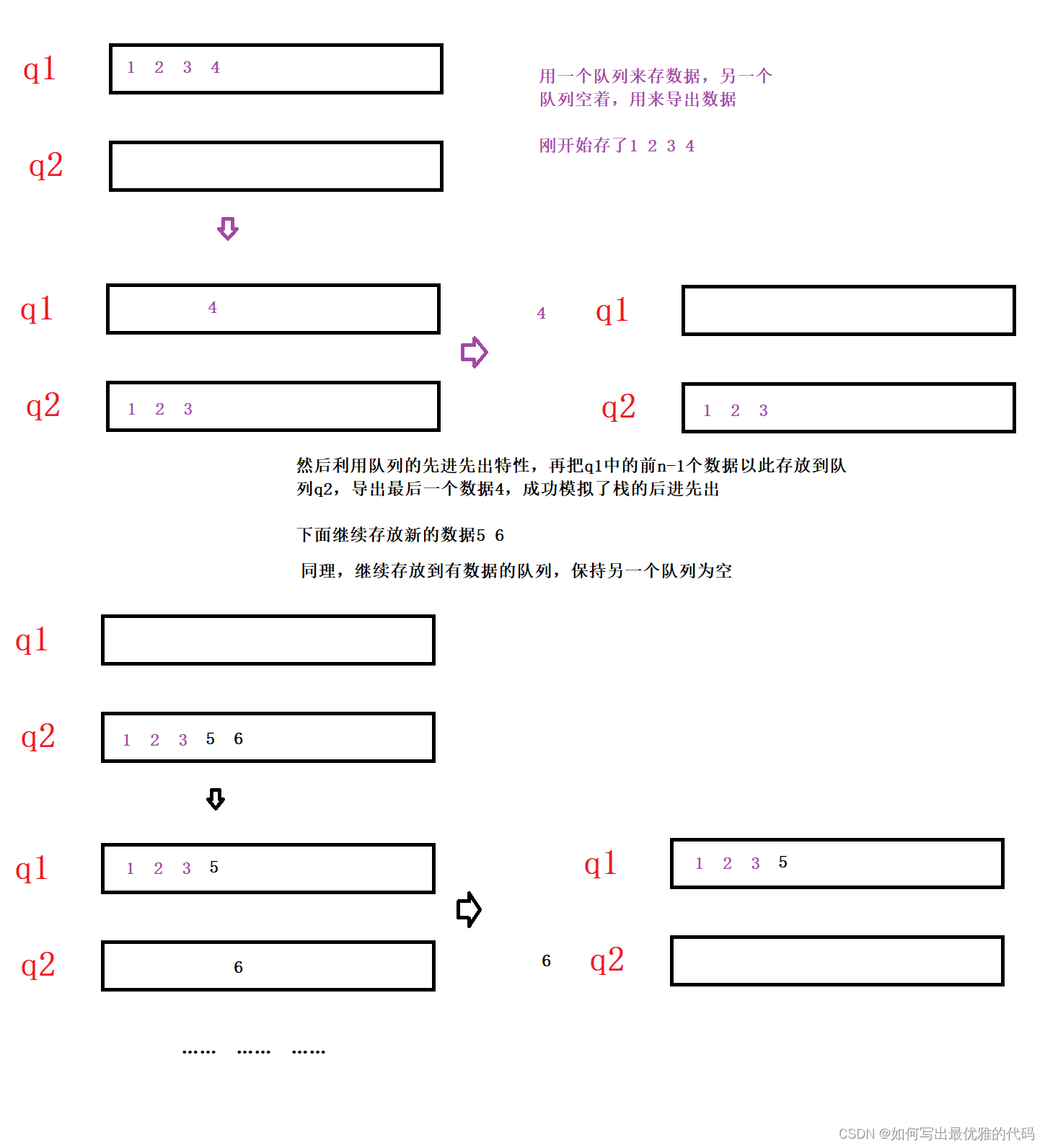

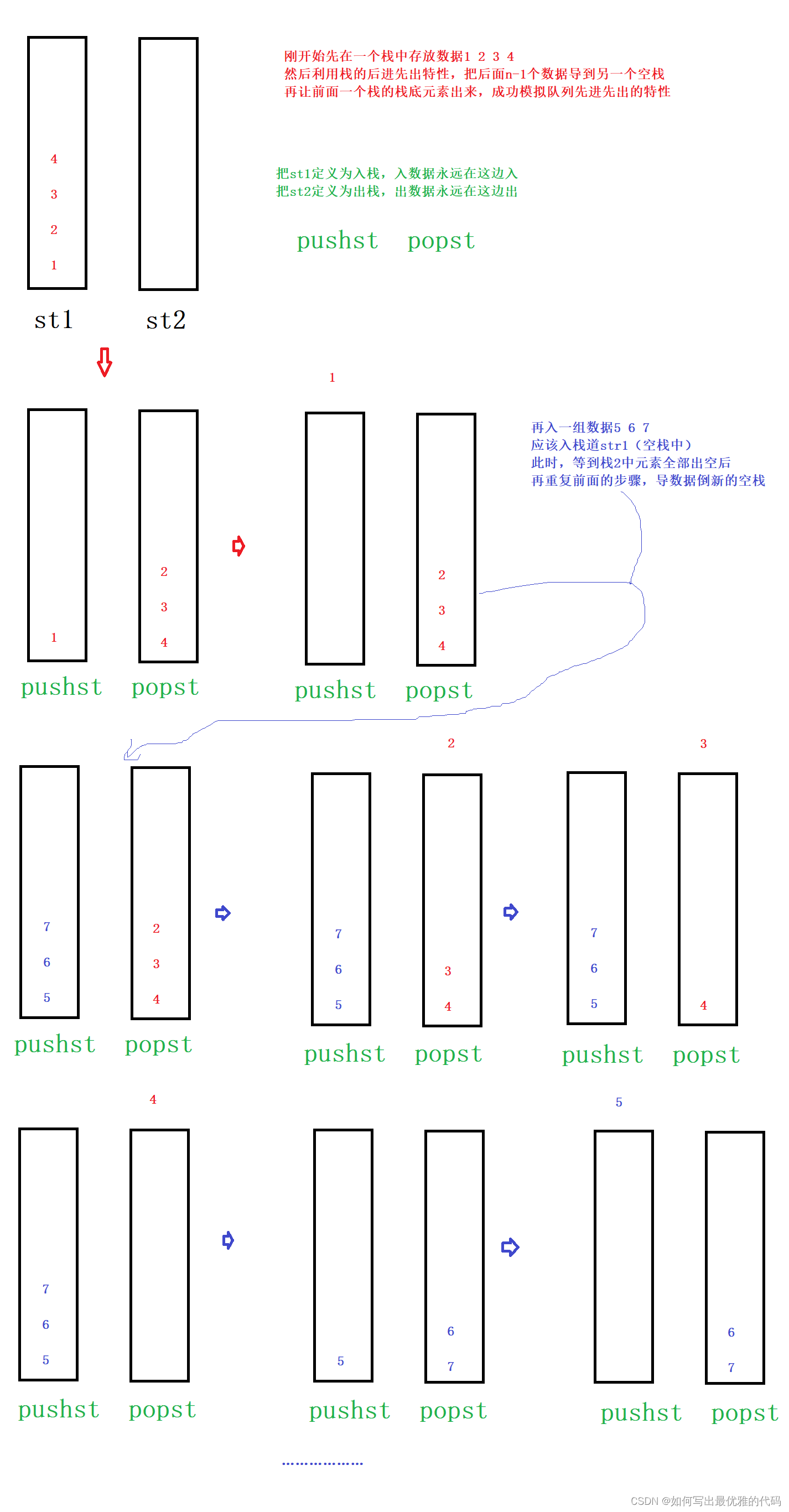
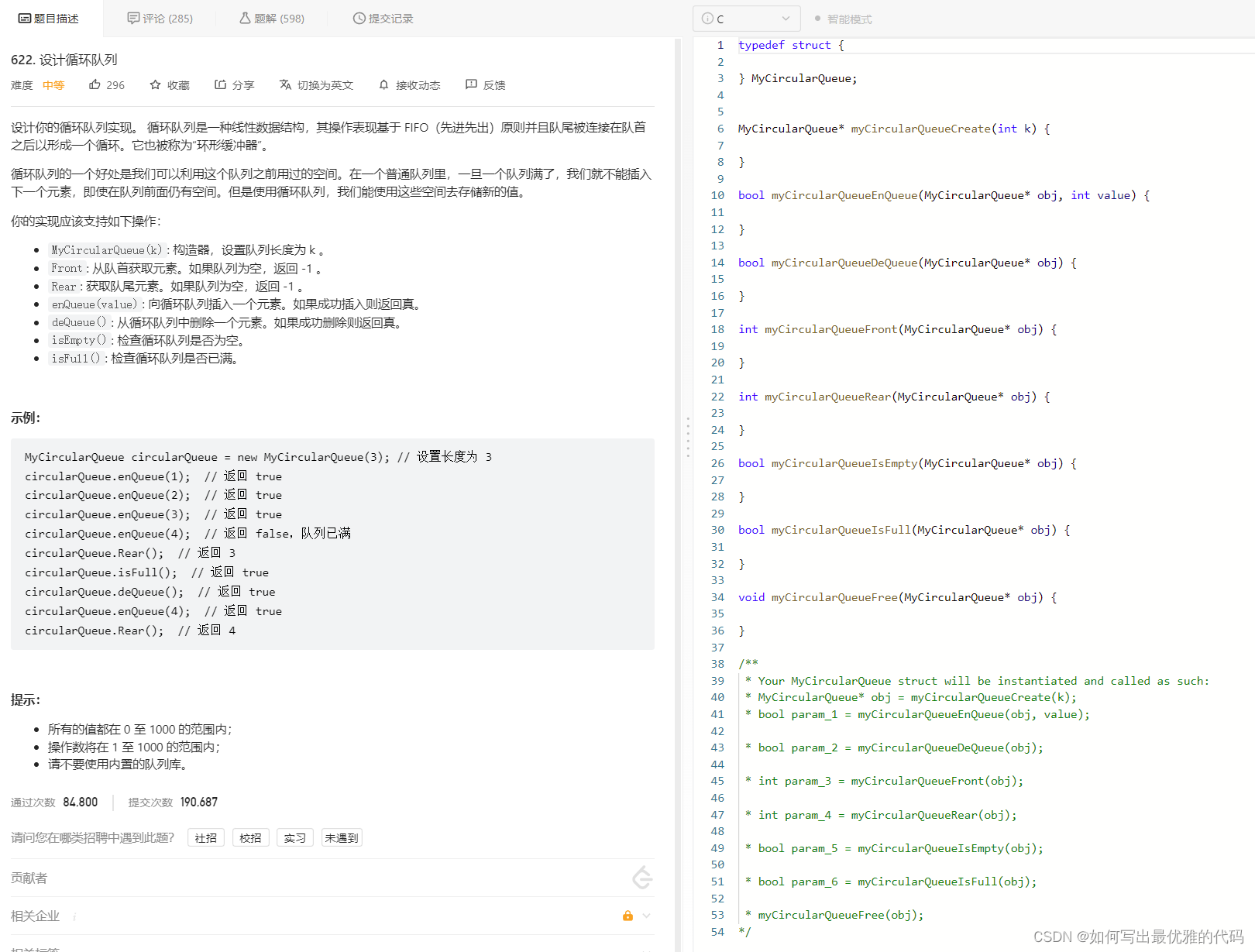

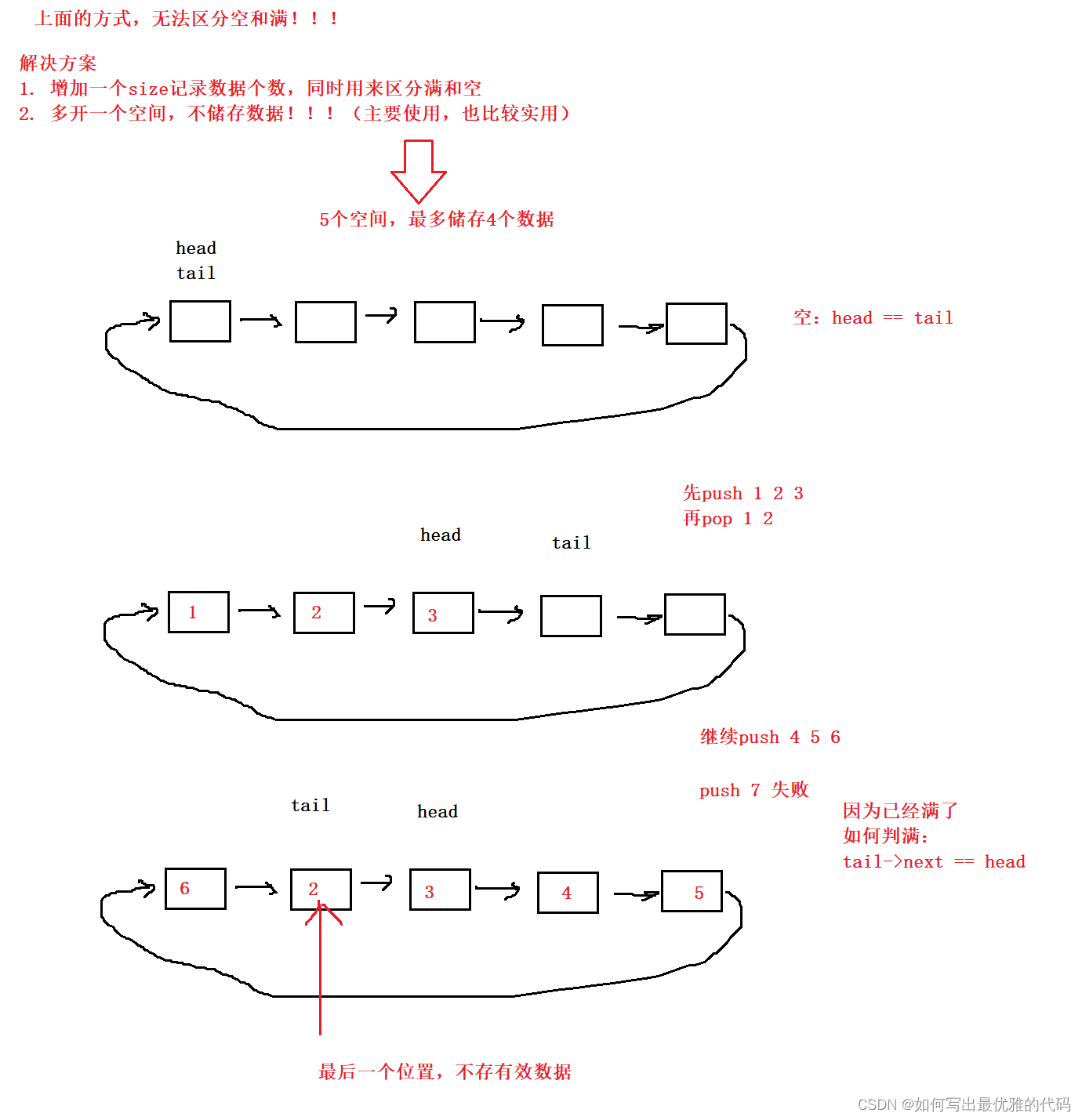
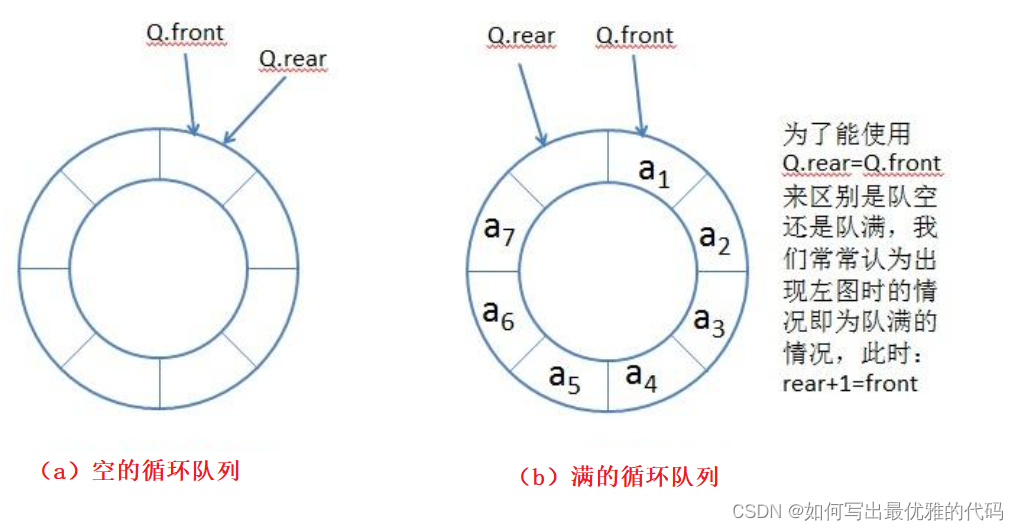
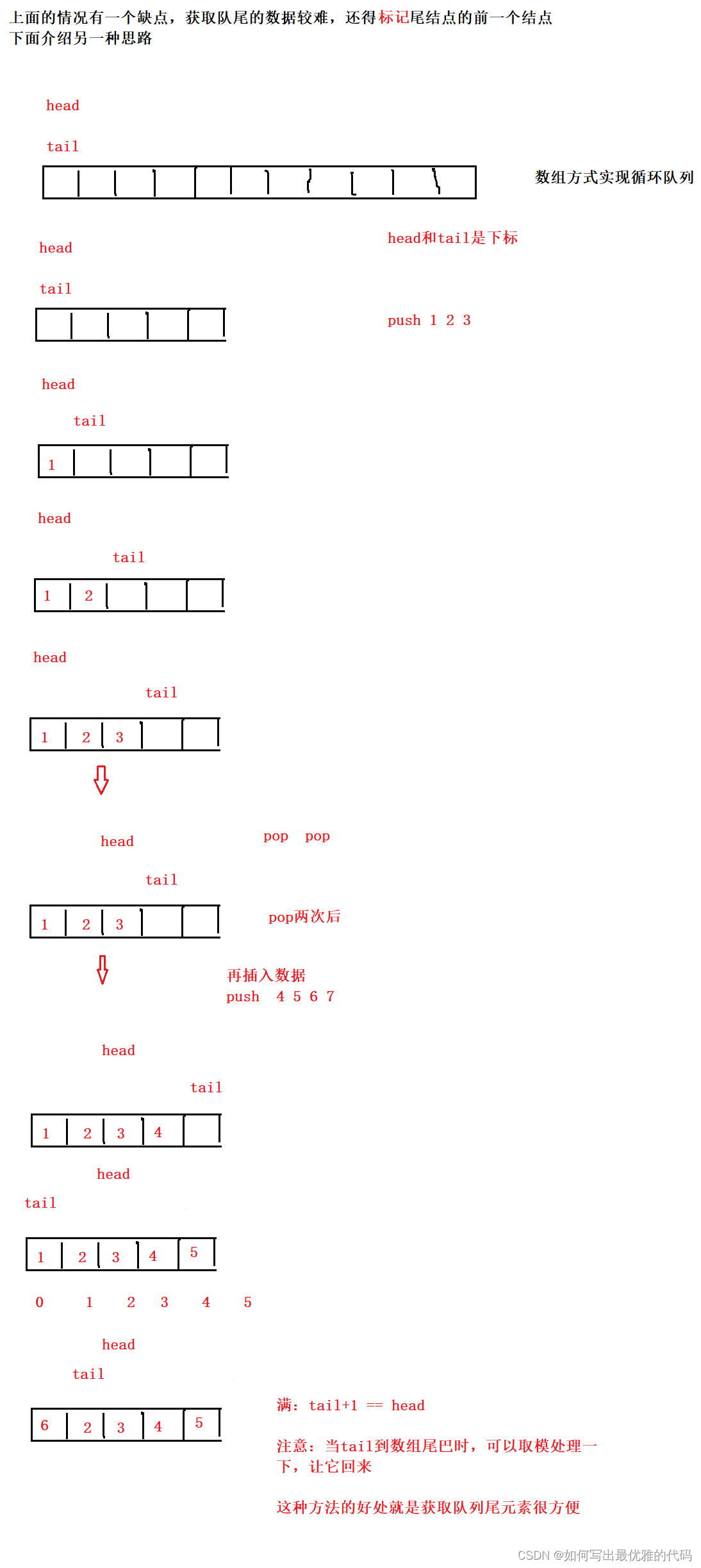















 595
595











 被折叠的 条评论
为什么被折叠?
被折叠的 条评论
为什么被折叠?










